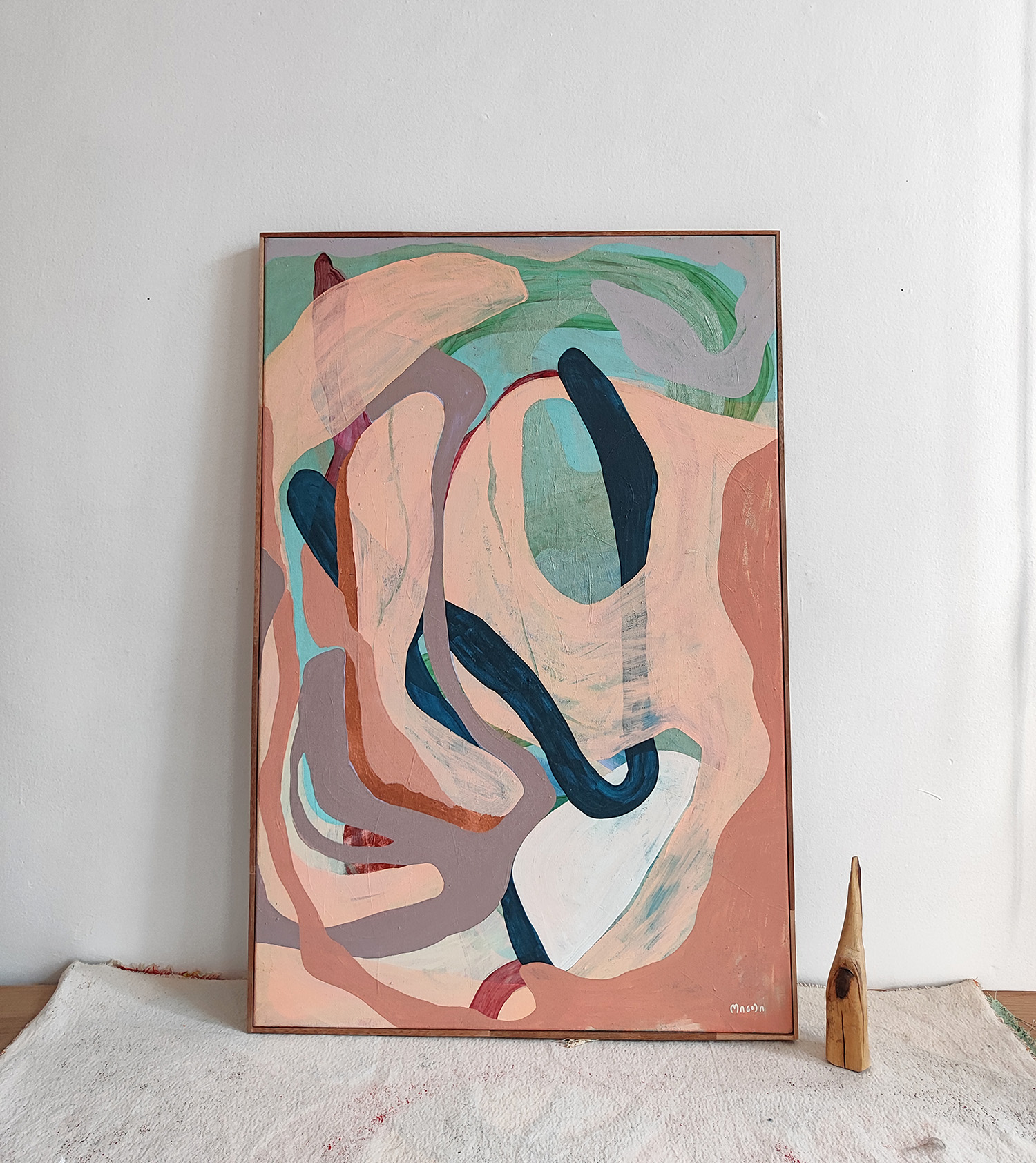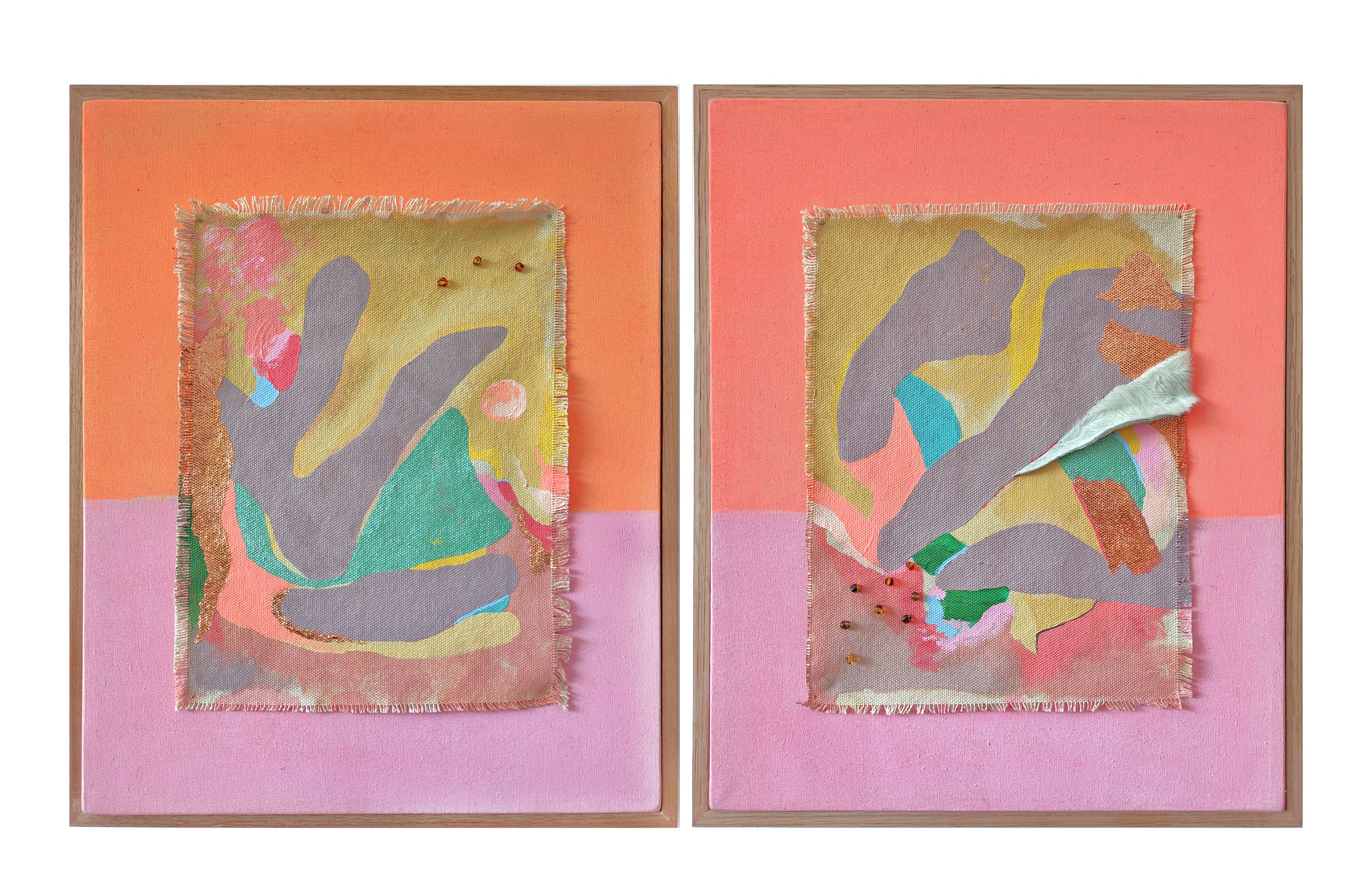Un pueblo a dónde volver
Mexico City, 2022
“Río del Oro”, 2022, Acrylic and gold leaf on raw cotton (diptych), 42x52 cm each, (next, the wood sculpture was hand carved by my grandfather in his town with local wood).
“A town return to”
“A town return to”
“I was talking with an european friend, she said how much she loved her hometown and one day she would return to live her last days there, her eyes full of joy and pride reflected a kind of security that I don't know, she left a void in me, she reminded me to the town of my grandparents, to which they returned to...
My grandparent's town is located in the Tierra Caliente, in the middle of the Sierra Madre de Guerrero, one of the poorest areas of the country, but very rich in natural resources, named Placeres del Oro, supposedly founded by miners, it is a beautiful town with crystalline streams, quartz hills, colorful cows, creole fruit trees and the great river of gold. My grandfather worked in the gold mine when he was very young, the gold ran out shorlty in the local mine and he had to migrate to Mexico City along with my grandmother. Around that time also, the economy of the region began to lean towards the planting of poppies, I used to listen to the local people talk about the hills of poppies, owned by the narco.
I spent all my childhood vacations in Placeres, my mother tells the same story, wonderful long summers bathing in the river with all the cousins, collecting pebbles, hikes to the quartz hill or to the paddocks, the Holy Week traditions, riding our uncle’s horses, looking excited at the cows walk to the river, eating creole fruit from the trees, we experienced so much peace and fun in remote nature.
For about four decades I have seen how the town has changed, street lighting arrived, the traditional architecture of adobe mud and clay was replaced by brick and concrete construction, from the corn mill to machinery, more cars, and fewer horses and cows; people's appearance changed too, from wearing cotton clothes, handmade dresses and guayaberas, to wearing branded polyester clothes, pirate snickers and plastic sandals. A lot of plastic and garbage in the river too, which also has disappeared over the years, my mother used to say that when she was a child, the river and the stream used to be three times wider, filled with water, now the water is scarce, and the river sometimes is just mountains of pebbles.
Many people from the town have gone to live in other states, or in the US, because in the region there aren’t opportunities, basic education is precarious and there aren’t jobs at all. The old local trades are disappearing, it seems that poppy planting is all what lives. The narco settled in the town a few years ago, now the owners of the few businesses in the town owe to them, and along the highway, you see just drug trucks, the military, and the federals.
I last went to my grandfather's funeral three years ago and honestly, I would not go back.”
This series began to take shape from several paintings that reminded me of the town of my grandparents, I unconsciously incorporated elements that represent aspects of the land of my ancestors, of the common people from remote, conquered and exploited regions.
My grandparent's town is located in the Tierra Caliente, in the middle of the Sierra Madre de Guerrero, one of the poorest areas of the country, but very rich in natural resources, named Placeres del Oro, supposedly founded by miners, it is a beautiful town with crystalline streams, quartz hills, colorful cows, creole fruit trees and the great river of gold. My grandfather worked in the gold mine when he was very young, the gold ran out shorlty in the local mine and he had to migrate to Mexico City along with my grandmother. Around that time also, the economy of the region began to lean towards the planting of poppies, I used to listen to the local people talk about the hills of poppies, owned by the narco.
I spent all my childhood vacations in Placeres, my mother tells the same story, wonderful long summers bathing in the river with all the cousins, collecting pebbles, hikes to the quartz hill or to the paddocks, the Holy Week traditions, riding our uncle’s horses, looking excited at the cows walk to the river, eating creole fruit from the trees, we experienced so much peace and fun in remote nature.
For about four decades I have seen how the town has changed, street lighting arrived, the traditional architecture of adobe mud and clay was replaced by brick and concrete construction, from the corn mill to machinery, more cars, and fewer horses and cows; people's appearance changed too, from wearing cotton clothes, handmade dresses and guayaberas, to wearing branded polyester clothes, pirate snickers and plastic sandals. A lot of plastic and garbage in the river too, which also has disappeared over the years, my mother used to say that when she was a child, the river and the stream used to be three times wider, filled with water, now the water is scarce, and the river sometimes is just mountains of pebbles.
Many people from the town have gone to live in other states, or in the US, because in the region there aren’t opportunities, basic education is precarious and there aren’t jobs at all. The old local trades are disappearing, it seems that poppy planting is all what lives. The narco settled in the town a few years ago, now the owners of the few businesses in the town owe to them, and along the highway, you see just drug trucks, the military, and the federals.
I last went to my grandfather's funeral three years ago and honestly, I would not go back.”
This series began to take shape from several paintings that reminded me of the town of my grandparents, I unconsciously incorporated elements that represent aspects of the land of my ancestors, of the common people from remote, conquered and exploited regions.

“El vuelo del conejo”, 2022, Acrylic and gold leaf on raw cotton, artist frame, 90x120 cm

“Forma Oro y Caballo”, 2022, Acrylic and gold leaf on raw cotton, artist frame, 60x90 cm




“Treasures of the sierra madre”, 2022, Acrylic and gold leaf on raw cotton, banak frame, 28x35 cm each

“Piedras de río”, 2022, Acrylic and gold leaf on raw cotton, unstreteched, 75x95 cm

“Atardeceres”, 2022, Acrylic, gold leaf, sheepskin and amber on raw cotton, banak frame, 40x50 cm each

“Arroyo”, 2022, Acrylic and gold leaf on raw cotton, caoba frame, 30x30 cm